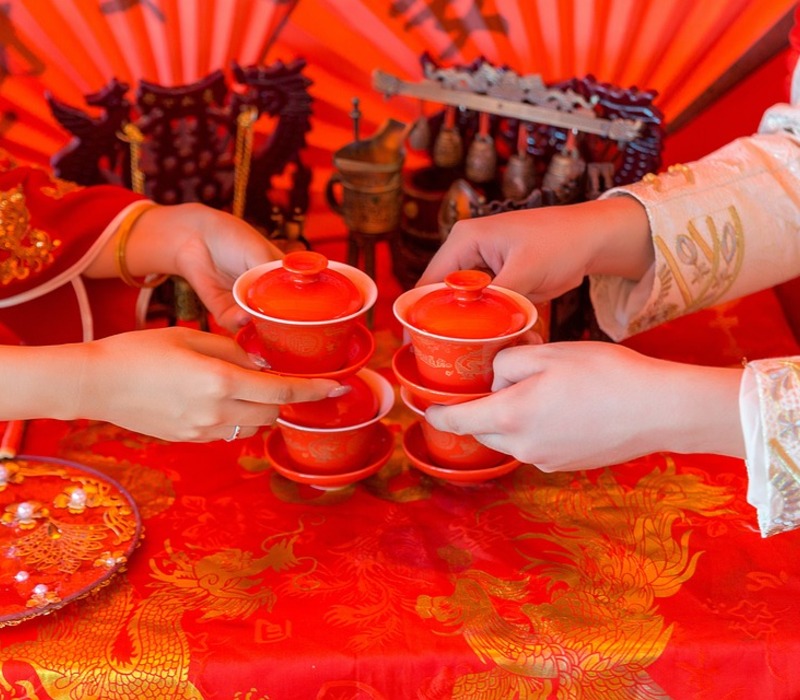In China, the bulk of the population drinks tea all day long as part of their culture. China tea was initially discovered by the Chinese Emperor Shen Nong in 2737 BCE, and its history can be traced back to the Tang Dynasty
Page Contents
Types of China Tea
Tea is regarded as one of the seven essentials of life in Chinese culture. China tea can be divided into five fundamental types:
Green, White, Yellow, Red, Oolong, and Dark tea (Puerh, Pu’er).
China tea is almost as iconic as Kung Fu is in Chinese culture.
| Green Tea | Green tea is processed with the finest care. As a result, the beverage has a chemical makeup that is most similar to a tea leaf in growth. It revitalizes the body and offers it energy and strength. |
| Yellow Tea | Yellow tea, which goes through the crushing process, is similar to green tea. It is less unpleasant to the stomach than green tea. Although its manufacture is difficult and laborious, its taste is peculiar, and it is extremely difficult to locate. |
| White Tea | White tea goes through minimal processing. It is made from a particular type of tea plant and is regarded more as medicine than just a tasty beverage in China. In contaminated megalopolis, this anticancer aid is beneficial for daily use. |
| Red Tea | Europeans refer to red tea as “black.” It carries the warmth and vitality of fire. It increases immunity and energizes. While Chinese tea is traditionally served at the table with sweets in our culture, it can also be consumed on its own without any additional ingredients. |
| Oolong Tea | Oolong is a complex tea with floral and fruity aromas. Very flavorful and adaptable. Due to the high concentration of fat-burning polyphenols, it has become incredibly popular nowadays for its ability to aid in weight loss. |
| Dark Tea | Dark tea is a unique variety of tea. Famous for its unique production method, which has led to a unique flavor, smell, and physical consequences. Pu’er, the most well-known dark tea, is manufactured using two distinct processes—shu and shen Pu’er—from leaves that are particularly from the Yunnan Province. |
China Tea Nutrition
| Total Calories | 1 gram |
| Protein | 0 gram |
| Fat | 0.4 g |
| Carbohydrate | 0.2 g |
Nutrients
| Nutrients | Quantity | Daily Intake |
| Copper, Cu | 0.02 mg | 0.75 % |
| Iron, Fe | 0.08 mg | 0.44 % |
| Magnesium, Mg | 1 mg | 0.25 % |
| Manganese, Mn | 0.04 mg | 2.2 % |
| Potassium, K | 9 mg | 0.26 % |
| Sodium, Na | 1 mg | 0.04 % |
| Zinc, Zn | 0.04 mg | 0.27 % |
| Riboflavin | 0 mg | 0.24 % |
| Thiamin | 0.01 mg | 0.67 % |
| Folate | 1 mcg | 0.25 % |
How to Make China Tea?
You can make any one of china tea by using the following steps.
- Pour boiling water quickly into each tea set, then drain the teapot and cups. It seeks to increase the temperature of tea sets and make sure that the temperature of the tea soup is fairly constant. A clean effect is also attained in the meantime.
- The quantity of tea leaves varies depending on the type of tea and the drinker. Put more tea if you like strong tea; less tea if you like mild tea.
- Fill the tea kettle with boiling water, pause for a moment, and then walk away from the soup. During the growing and processing processes, dust and other contaminants can contaminate tea leaves, and pesticide residues may be present on the tea leaf’s surface. As a result, the first batch of tea should be discarded because it can contain toxic ingredients. However, some tea has already been thoroughly cleaned before processing, therefore this step is not necessary.
- Typically, it’s best to pour into water that fills up about 4/5 of the tea kettle, leaving room for the tea leaves to spread out. Typically, the brewing process takes 5 minutes. The greater the flavor of the tea will be the longer it is brewed.
- Before pouring the china tea into the guests’ cups, it should first be poured into the warm fair cup, and shaken to distribute the tea evenly. As a result, whether guests are served early or late, the tea tastes the same.
- Now take small sips and enjoy your life with every sip of tea.
Benefits of China Tea
China tea has several unique ingredients like theine and tea polyphenols that are good for the wellness of our bodies. What miraculous advantages might this necessary beverage provide for our bodies here on Earth? Let’s look at the fantastic 7 benefits of Chinese tea listed below.
Reduce the Risk of Cardiovascular Disease

Stroke, high cholesterol, and hypertension may be lifelong issues for some elderly and obese persons. One of the key components of china tea is tea polyphenols, which can help prevent hypertension, high cholesterol, and stroke, and maintain appropriate blood sugar levels. The most recent British research indicates that drinking more than three cups of tea every day can lower your risk of myocardial infarction by 70%. Additionally, studies from Finland and France demonstrate that drinking two to three cups of tea every day will significantly reduce your risk of suffering a stroke. The following is some tea-drinking advice: To benefit most from tea’s ability to lower your risk of cardiovascular disease, drink 5–6 cups of green tea each day.
Reduce the Risk of Diabetes
China tea can assist you in getting rid of diabetes and other life discomforts. Those who drank more than six cups of green tea per day had a 33% lower chance of acquiring diabetes than those who drank less than one cup per week, according to a long-term follow-up of 17,000 males and females between the ages of 40 and 65. The best teas for patients with diabetes are green tea, black tea, and white tea since they have higher levels of tea polyphenols, polysaccharides, and microelements. However, they shouldn’t consume strong tea.
Lose Weight
Theine is the key component in this China herbal tea that has the potential to help people lose weight since it can encourage the release of gastric juice, aid in digestion, and increase the body’s capacity to break down fat. According to studies conducted abroad, regularly drinking tea can reduce your BMI and shrink your waistline. Black tea, oolong tea, green tea, and Pu’er tea can all be very helpful to you if you are trying to stay active.

Improve Memory
According to studies, tea polyphenols are also responsible for this Chinese tea effect of boosting memory. It can help your brain function better in several ways, raising learning and working efficiency and improving your memory faculty. Human memory and learning are largely based on the central nervous system, which also underlies all mental activity. Tea can act as a stimulant to keep your mind sharp and clear throughout your daily study or work schedule. It can also add excitement to this system. According to a recent British study, daily consumption of black tea, green tea, and peppermint tea can boost memory.
Resist Radiation
According to several official research, tea polyphenols can absorb radiation from the outside, protecting cells from radiation damage and alleviating damaged ones. Clinical investigations have demonstrated that tea extract has a positive impact on the radiation therapy-induced reduction in blood cells and leucocytes as well as the treatment of minor radiation sickness in cancer patients. Try green tea, dark tea, and oolong tea to assist your body resist radiation if you frequently work outdoors or need to sit in front of a computer.
Improve Bone Density
We can maintain dense bones and avoid various ailments brought on by the loss of sclerotin because tea also contains fluorine, plant estrogens, and potassium. According to Taiwanese research, those who drink tea have denser bones and are less likely to suffer a hip fracture. The best option in this case is green tea.
Improve Muscle Endurance
Tea can benefit our physical endurance as well. Your body can burn fat naturally and more quickly, reduce weariness, and withstand prolonged physical activity thanks to an antioxidant called catechin. The effect is more remarkable the more green tea you drink.
Conclusion
If you like this article, you might be interested in other articles too.

